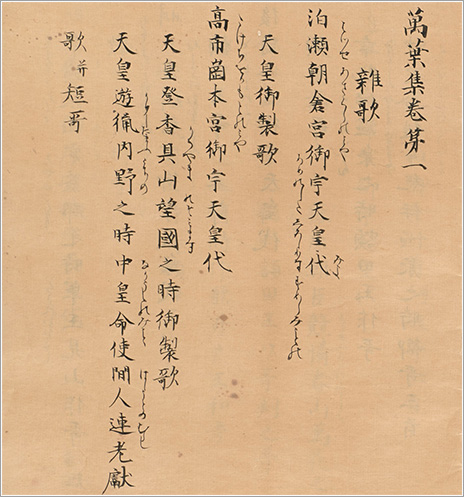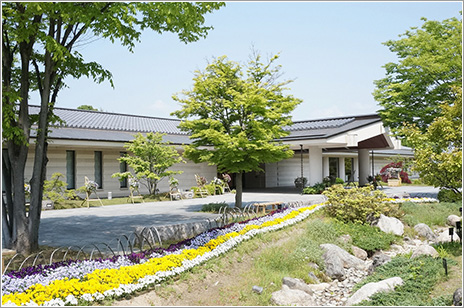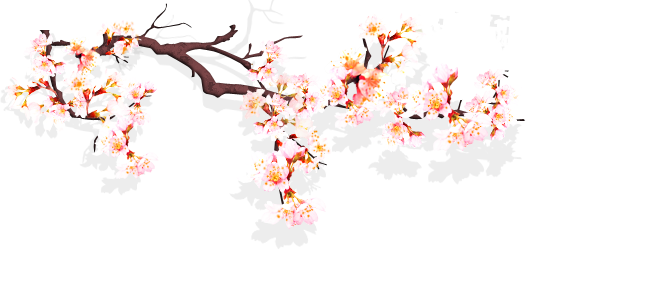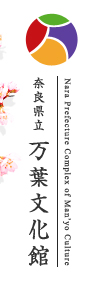Japanese literature has a history stretching back well over a thousand years, and has features different from that of Western literature. Among the three genres of epic poetry, lyrical poetry and dramatic poetry based on Greek literature, lyrical poetry is predominate in Japanese literature. Waka has fixed-form lyrics unique to Japanese literature, and its typical pattern is a short poem consisting of 31 syllables, which are divided into 5, 7, 5, 7, and 7. This is also called Tanka meaning short poem, and is familiar to modern Japanese people. Composing Tanka is popular among Japanese. In ancient times, there were much longer types of verse, including Choka and Sedoka. Choka consisted of repetitions of 5 and 7 syllables, and ended with 5, 7, and 7. Sedoka consisted of 5, 7, 7, 5, 7, and 7 syllables.
Other than these verses, there are fixed-form verses called Haiku and Senryu, which consist of 5, 7, and 5 syllables, and a unique fixed-form verse called Renga. In Renga, the first part of Tanka (5, 7, and 5 syllables) is composed by one person, and another person composes the second part of it (7 and 7 syllables), and then this process is repeated several times by plural poets to compose one poem. They are all based on the combination of words with 5 or 7 syllables, and came into being in middle ages. Waka was the matrix of these types of verses. In Japanese classical literature, represented by “the Story of Genji”, Waka appears in the important parts of stories, and the combination of 5 and 7 syllables is considered important to make sentences sound rhythmical. Waka holds an important status in Japanese literature.
Waka already appear in the Man’yō-shū, a collection of poems composed about the 7th and 8th century. Even before this, folk songs, court songs and oral verses called Kayo, associated with performing arts, had been passed down by the people. However, in ancient Japan, which was very receptive to introducing culture from various countries and areas, Waka was particularly stimulated by Kanshi, fixed-form verses from China, and was established as the fixed-form verse of ancient Japanese written poetry. In public places, being well-educated in Chinese literature was highly valued. On the other hand, at private places, Waka was passed down from generation to generation, and is deeply related to the formation of thought and art in Japan. Thereby, Waka is one of the special features of Japanese culture, and is still alive in modern life.

The Man’yō-shū is the earliest anthology of poetry existent in Japan. It contains about 4,500 Waka in its 20 volumes. Presumably, it is a collection of poems from the early 7th to middle 8th century. However, some poems were composed by people in the early 5th century.
The poems were composed by people ranging from successive emperors, members of the Imperial Family, courtiers including aristocrats, and Sakimori or soldiers garrisoned at strategic posts, to common people. Nukata-no Ôkimi, a lady from the imperial family, and government officials such as Kakinomoto-no Hitomaro, Yamano-ue-no Okura and Ôtomo-no Yakamochi are well known even today. Including them there are about 500 poets whose names are inscribed in the Man’yō-shū, however more than half of its poets are unknown.
As both men and women composed poems, the Man’yō-shū contains many poems about love. In Eastern Asia in the ancient times, there was an event called Utagaki, in which men and women exchanged songs to win each others’hearts. This custom can no longer be seen in modern Japan, however several other countries have preserved this even today. At banquets participants pretended to be lovers, compose verses and exchanged them. Other poems are about the rituals of emperor’s trips outside the palace, annual events in the court, banquets by aristocrats, funerals, etc. Also, various literal approaches were taken in composing poems, for example, some poems are based on Japanese stories and Chinese literature, and poets competed to see whose poems were the funniest.
Most of the Man’yō-shū poems were composed in Nara, the political center in those days. Also many poems were composed in its surrounding area. Some of the poems include place names ranging from the Tohoku region in the north to the Kyusyu region in south. This is indicative of areas over which the authoritative power of emperors prevailed. At the local administration offices, government officials sent from the capital assumed positions to administer the local areas.
Poems composed and collected by these ancient people have survived as the Man’yō-shū, and convey the features of Japan in those days to present day.
There are no known details about when and who comprised the Man’yō-shū. However, among the poems whose composed date can be identified, the earliest one was composed on January 1st, 759 (by lunar calendar), and the last several volumes of the Man’yō-shū are edited in a poetry-diary style focusing on poems such as Ôtomo-no Yakamochi (718? - 785) and poets who were close friends to him. Thereby, presumably, not much later than 759 (the end of the 8th century), Ôtomo-no Yakamochi, a poet and aristocrat, took an important role in editing this anthology.
The editors set several themes in compiling the Man’yō-shū, and poems sharing similar contents are included in a volume. The three representative themes are as follows; poems for public occasions (poems praising the glory of emperors and capitals, poems at rituals, etc.), poems about love, and poems for condolence. For example, its first volume is exclusively comprised of poems for public occasions, and the second is of love poems and condolences. Additionally, more detailed themes are given to each volume; that is, a volume for each representative theme categorized by season (for example, poems of love in spring, poems of love in summer, etc.), a volume for poems by Sakimori soldiers, a volume for poems associated with legends and stories, etc. Thereby, each of the 20 volumes of the Man’yō-shū was edited to give them individual characteristic respectively.
In ancient Japan before the 8th century when the Man7yo-shu was comprised, Japan did not have its own letters for writing. In those days, people used characters from its neighboring country China, and government officials wrote documents in classical Chinese (Chinese language in those days). However, because it is impossible to write Waka, Japan’s unique verse, in Chinese languages, people in Japan created a method to apply Chinese characters to Japanese pronunciation by making use of the sounds of Chinese language.
Surrounded by ocean in four directions, Japan is an island country in the Far East. This might give you an image of Japan isolated from the flourishing cultures outside the country. However, in the days when the Man’yō-shū was compiled, objects of international flavor flooded into this country. The Buddhist statues housed in Asukadera Temple and Horyuji Temple in Nara were made in Asuka period and Hakuho period (the 7th century) in accordance with the Northern Wei style in North of China. On the other hand, their contemporary Buddhist statue in Chuguji Temple was made in accordance with the Southern Liang style in South of China. In the Takamatsuzuka burial mound and the Kitora burial mound constructed from the end of 7th century to the early 8th century are mural paintings of the four dieties such as Suzaku and Genbu protecting each direction, uranometry called Seishuku, and the Chinese zodiac. These paintings indicate strong influences on Japan from both Chinese and Korean cultures. Among the treasures once used by Emperor Shomu in the 8th century (701-756, reigned 724-749) and stored in the Shosoin repository are the silk fabric known as Shuryomonkin, whose pattern of a lion being hunted with arrows was popular in Persia, and a screen called Jukabijinzu-byobu, ‘beauty under the sacred tree.’ Both of the patterns were brought to Japan through the West Asian areas.
Surrounded by the wealth of culture brought from outside Japan, poems in the Man’yō-shū have rich international flavor. Imperial family, aristocrats, and government officials read many historical documents and verses from China, and Buddhist monks read through sutras translated into Chinese. Among them, Ôtomo-no Yakamochi, an aristocrat, composed poems in which Jukabijinzu, a picture of beauty under the sacred tree, is described vividly.
This is because Japan eagerly tried to introduce cultural objects by sending missions to China in the Tung Dynasty and in the Sui Dynasty, and by exchanges with envoys from the Kingdom of Shilla in the Korean Peninsula, the Kingdom of Bo Hai at the coastal area of China, etc., and established diplomatic ties with these countries. Above all, China was regarded as a role model for Japan in all aspects including politics, economy, and culture. Embassies to the Tang Dynasty were commissioned about 17 times for 170 years untill the end of 8th century, and were sent to Changan (present-day Xian City), which was the international capital city of China. Additionally, students and monks from Japan stayed tens of years and worked hard to understand advanced culture and to introduce its institutions and products.
We live in an internationalized and globalized society, and are in constant contact with foreign civilization and foreign culture. There are sometimes clashes between civilizations, and at other times the gap between cultures becomes obvious. In such situations, it is important to understand each culture has unique elements as well as universal elements.
Some cultural factors can be accumulated in written language, but others cannot. Among these written documents and books, works which should be shared in society as common properties are classics.
The Man’yō-shū should be called the corpus for verses which convey the real voice of people who lived in the 7th and the 8th centuries. Today, Man’yō-shū has a place as the classic of classical Japanese literature, and plays an important role as a symbol of Japanese culture. There are some doubts if the Man’yō-shū reflects the real voice of our distant ancestors. However, there is no doubts that the learning of Man’yō-shū is the base for study of traditional short-poems, because the format of short poetry passed down among Japanese people for a long time was established in the time of the Man’yō-shū.
The compiling of a history of Japan started in the 7th century, and it bore fruits in completing “Kojiki”, the History of Ancient Japan, and “Nihonshoki”, the Chronicle of Japan in the early 8th century. These historical works were edited during the time when the foundation of Japan as a nation was laid. The government was eager to establish Japan as a fully-fledged nation by making use of Chinese characters, Confucianism, the Ritsu-Ryo codes, and Buddhism as its fundamental elements. Sharing these as common factors with other countries, Japan started its path as an outlying state in the cultural sphere of China. In time, the Ritsu-Ryo legal system centering on the emperor was established. This administrative system comprised in those days prevailed in this country for a long time afterwards. The names used for administration, such as Sho (ministry) and Daijin (minister), and names for local administrative units such as Do (prefecture), are used today. Therefore, learning 7th to 8th century history is to understand the foundation of Japanese history and culture.
The Man’yō-shū brings together this collection of poems of those days. Learning the Man’yō-shū is listening to the voice of ancient people who drew the ground design for Japan as a state. The capitals of the time were concentrated in the Kinki region, especially in Nara Prefecture. The Asuka-kyo Capital (592-694), the Fujiwara-kyo Capital (694-710), and the Heijo-kyo Capital (710-784) were all located in this prefectural area. In other words, Nara was situated as the capital of the Man’yō-shū.
Nara Prefecture is the home of the Man’yō-shū and this anthology is, and will continue to be, an important historical heritage for the prefecture. In today’s international society, we are asked to be aware of our culture, and to send the messages to a wider world audience for deepening mutual understanding. In order to responding to the needs of the time, we came up with the concept of establishing an international center to disseminate information about the Man’yō-shū. Herein, the Complex of Man’yō Culture comprises an art museum for better understanding of the anthology through Japanese style paintings, a museum to experience the era, and an institute to study the Man’yō-shū and to amass and disseminate knowledge about it. The Complex of Man’yō Culture hopes to continue this dissemination of information about the Man’yō-shū and its culture both within and outside of Japan.




